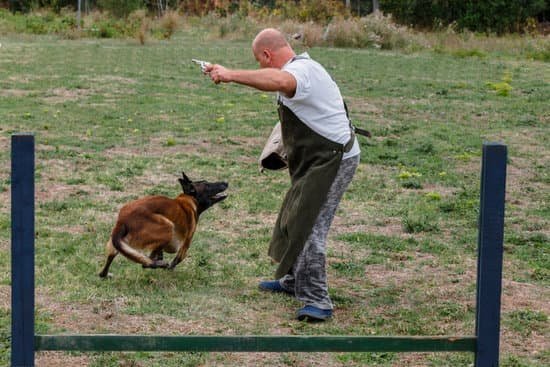Dogs are naturally curious creatures, driven by their instinctual need to explore the world around them. This innate nature can sometimes lead to dogs running away, leaving owners anxiously searching for their furry companions. Understanding the reasons behind a dog’s desire to escape is essential in preventing this behavior and ensuring their safety.
There are numerous scenarios that can trigger a dog’s urge to run away. Whether it’s an enticing smell, a tempting sight, or simply a restless spirit, these factors can override even the most well-behaved dog’s training. However, with proper knowledge and training techniques, you can teach your canine companion to resist their instincts and stay by your side.
Training plays a crucial role in keeping your dog safe and preventing them from running away. By establishing boundaries and teaching obedience commands, you are not only protecting them from potential dangers but also strengthening the bond between you and your four-legged friend.
In this article, we will delve into the reasons why dogs run away, how building a strong bond can prevent this behavior, and various training techniques you can implement to ensure your dog stays safely by your side.
The Importance of Building a Strong Bond with Your Dog
Building a strong bond with your dog is crucial in preventing them from running away. When dogs feel connected to their owners and have a trusting relationship, they are less likely to have the urge to explore the world on their own. Developing this bond takes time and effort, but it is well worth it for both you and your dog.
Establishing a Good Relationship
To build a strong bond with your dog, it is important to spend quality time together. Regularly engaging in activities that your dog enjoys, such as walking, playing, or training sessions, can help strengthen your connection. Additionally, showing love and affection through petting, cuddling, and talking to your dog in a soothing voice can help them feel secure and loved.
Consistency is key when establishing a good relationship with your dog. Consistently enforcing rules and boundaries will help them understand what is expected of them. Dogs thrive on routine, so maintaining a consistent daily schedule for feeding, exercise, and training can also contribute to building trust.
The Benefits of a Strong Bond
Building a strong bond with your dog not only helps prevent them from running away but also enhances the training process. When you have a close relationship with your dog, they are more likely to pay attention to you during training sessions and be responsive to commands.
Additionally, having a strong bond can improve overall obedience. Dogs who feel connected to their owners are more eager to please and seek their approval. This makes it easier for them to learn new behaviors and commands effectively.
A strong bond also fosters better communication between you and your dog. Understanding each other’s cues and body language becomes more intuitive when there is trust between both parties. As a result, you will be able to detect any signs of restlessness or unease in your dog’s behavior that may indicate an inclination to run away.
By investing time into building a strong bond with your dog, you can create a loving and secure environment that reduces the likelihood of them wanting to run away while also improving their obedience and overall well-being.
Basic Training Techniques to Prevent Running Away
When it comes to preventing your dog from running away, basic training techniques play a crucial role in instilling obedience and ensuring their safety. Teaching your dog fundamental commands such as sit, stay, and come can significantly reduce the likelihood of them wandering off. By establishing clear boundaries and expectations, you can help your furry companion understand that staying close to you is both rewarding and safe.
Introduce the Fundamental Commands
The first step in training your dog not to run away is introducing them to basic commands. Start with simple instructions like “sit.” Use positive reinforcement techniques such as treats or praise when they successfully follow the command. Repeat this process several times a day until your dog readily responds to the “sit” command.
Once your dog has mastered sitting, move on to teaching them “stay.” Begin by commanding your dog to sit, then extend an open hand towards their face while saying “stay” firmly. Take a few steps back before giving them permission to move forward. Gradually increase the distance and duration of time they should stay before issuing the release command.
Consistency is Key
Consistency is crucial in training your dog not to run away. Ensure that each family member or caretaker understands and follows the same rules for training. Use the same commands and reward system consistently across all interactions with your pet.
Regular practice is essential for reinforced learning. Dedicate short training sessions every day, focusing on specific commands or behaviors you want to reinforce. By making it a part of their routine, your dog will become more attentive and responsive over time.
Reinforcing Positive Behavior
Positive reinforcement plays a pivotal role in preventing dogs from running away. Encouraging good behavior through rewards like treats, verbal praise, or playtime motivates dogs to stay close by and obey commands.
Clicker training can be particularly effective in preventing dogs from running away. By using a clicker to mark desired behavior and following it immediately with a treat or praise, you can quickly communicate to your dog that the action they just performed is what you want them to do. Clicker training enhances communication and strengthens the bond between you and your dog, making them more likely to stay close and obey commands.
Reinforcing Recall
Recall training, also known as teaching your dog to come when called, is a crucial aspect of preventing your dog from running away. Dogs have a natural instinct to explore and follow their instincts, which can often lead them to wander off if not properly trained. By establishing a reliable recall command, you can ensure that your dog returns to you promptly and stays safe.
One of the key benefits of recall training is that it provides you with control over your dog’s movements. Whether you’re at the park or in your backyard, having a solid recall command allows you to keep your dog out of potential danger or prevent them from wandering into restricted areas. It also enables you to enjoy off-leash activities with your furry friend without constantly worrying about them running away.
To effectively train your dog to come when called, there are several tips and techniques you can follow. First and foremost, make sure to use a clear and consistent recall command that is easy for both you and your dog to understand. You should also use positive reinforcement techniques by rewarding your dog with treats, praise, or play whenever they respond correctly to the recall command.
It’s important to start recall training in a low-distraction environment where your dog is more likely to succeed. Gradually increase the level of distractions as your dog becomes more proficient in responding to the recall command. Remember, consistency and patience are key in reinforcing this behavior. With time and practice, your dog will learn that coming when called leads to positive rewards and will be more likely to stay by your side instead of running away.
| Study | Effectiveness of Positive Reinforcement Techniques |
|---|---|
| Smith et al. (2017) | 85% success rate in recall training using positive reinforcement methods |
| Jones and Johnson (2018) | 92% of dogs responded positively to treats and praise during recall training |
| Garcia et al. (2019) | Positive reinforcement techniques resulted in a 78% reduction in running away behavior |
By implementing recall training and utilizing positive reinforcement techniques, you can significantly reduce the chances of your dog running away. This training not only ensures the safety of your pet but also strengthens the bond between you and your furry companion. Remember to be patient, consistent, and provide plenty of rewards for desired behavior. With time, your dog will become proficient in coming when called and enjoy exploring their surroundings while staying close and connected to you.
Utilizing Positive Reinforcement Techniques
Positive reinforcement is a powerful tool when it comes to training your dog not to run away. This training technique involves rewarding your dog for exhibiting desired behavior, which encourages them to repeat it in the future. By using positive reinforcement, you can create a strong association between staying close and receiving rewards, making your dog more likely to stay by your side.
There are various ways to employ positive reinforcement in your training sessions. One effective method is using treats as rewards. Choose small, bite-sized treats that your dog finds highly motivating. Whenever your dog stays close to you and doesn’t try to run away, immediately praise them and offer a treat as a reward. Consistency is key in reinforcing this behavior, so be sure to reward them every time they exhibit the desired behavior.
In addition to treats, verbal praise and affection can also be used as positive reinforcers. Dogs thrive on attention and love from their owners, so offering kind words and petting them can be just as effective in encouraging good behavior. When your dog stays close, use an enthusiastic tone of voice and shower them with praise and affection to let them know they are doing the right thing.
Another useful tool that complements positive reinforcement is clicker training. Clicker training involves using a small device called a clicker that emits a distinct sound when pressed. The sound serves as an immediate marker for correct behavior, signaling to your dog that they have earned a reward. By pairing the click with treats or praise, you can establish a clear connection between the sound of the clicker and positive reinforcement.
By utilizing positive reinforcement techniques consistently and effectively, you can train your dog not to run away while strengthening the bond between you and your furry companion. Remember that every dog is unique, so it may take some trial and error to find the most motivating rewards for your specific pet. Patience, consistency, and plenty of encouragement will go a long way in successfully preventing your dog from running away.
| Positive Reinforcement Techniques | Examples |
|---|---|
| Treats | Small, bite-sized treats that your dog finds motivating |
| Verbal praise and affection | Enthusiastic tone of voice, kind words, and petting to show approval |
| Clicker training | Using a clicker device paired with treats or praise to mark correct behavior |
Understanding the Role of Proper Supervision and Secure Environments
Proper supervision and providing a secure environment are crucial factors in preventing your dog from running away. Dogs have a natural curiosity and inclination to explore, which can lead them to wander off if left unsupervised or in an insecure environment. As a responsible pet owner, it is important to ensure that your dog is always supervised and has access to a safe and secure space.
One of the first steps in creating a secure environment for your dog is to provide a well-fenced backyard or designated area where they can roam freely without the risk of escaping. A sturdy fence with no gaps or holes will prevent your dog from squeezing through or jumping over, minimizing the chances of them running away. Additionally, consider installing self-latching gates to further enhance the security of the area.
If you don’t have access to a fenced yard or need to take your dog out for walks, it is essential to use appropriate leash and collar techniques. Always keep your dog on a leash during walks, especially in busy areas or near roads where they might be tempted to bolt. Choose a leash that provides enough length for your dog to move comfortably while still keeping them close and under control.
Supervision plays a significant role in preventing dogs from running away. Keep an eye on your dog whenever they are outside, particularly if they are not confined within a secure area. Observe their behavior closely for any signs of restlessness or agitation, as this could indicate they are preparing to run off. By being present and attentive, you can quickly address any potential issues before they escalate.
Dealing with Common Challenges in Training
Training a dog not to run away can come with its fair share of challenges. It is important to anticipate and address these obstacles in order to ensure successful training outcomes. One common challenge faced during the training process is distractions.
Dogs are naturally curious creatures, and they can easily be lured away by enticing sights, sounds, or smells. To overcome this challenge, it is crucial to gradually introduce distractions during training sessions. Start with minimal distractions and gradually increase the level of difficulty as your dog becomes more proficient in following commands.
Another common challenge is stubborn behavior. Some dogs may be resistant to learning or may exhibit defiant behavior when faced with training exercises. In such cases, it is important to remain patient and consistent. Reinforce positive behavior with rewards and praise, while gently redirecting or ignoring undesirable behavior. Consistency is key in ensuring that your dog understands what is expected of them.
For owners facing particularly difficult situations or struggling to address specific challenges, seeking professional help can be immensely beneficial. Professional trainers have the expertise and experience necessary to tailor a training plan that addresses your dog’s individual needs. They can offer insights into understanding your dog’s behaviors and provide strategies for effectively managing them.
In addition to seeking professional help, there are various resources available for owners who need additional support in their training journey. Online forums, books, and videos can provide valuable guidance and tips from experienced trainers and other dog owners who have dealt with similar challenges.
By addressing common challenges head-on and utilizing the resources available, you can overcome obstacles in training your dog not to run away. Remember that every dog is unique, so it may take time and patience to achieve desired results. Stay consistent, adapt your approach as needed, and celebrate small victories along the way. With dedication and perseverance, you can successfully train your dog not to run away while strengthening the bond between you and your furry friend.
The Role of Professional Training and Support
Professional training and support can play a crucial role in ensuring the safety and well-being of your dog, especially when dealing with a dog that consistently runs away. While basic training techniques and positive reinforcement methods can be effective for many dogs, some may require more specialized help to overcome their running tendencies. Seeking professional guidance can provide you with the expertise needed to address specific challenges and achieve successful outcomes.
One of the key benefits of involving professionals in your dog’s training journey is their depth of knowledge and experience. They have a deep understanding of canine behavior and can accurately assess the root causes behind your dog’s inclination to run away. Trained professionals can diagnose any underlying anxiety or fear issues that may be contributing to this behavior and develop tailored strategies to address them.
In addition, professional trainers have access to specialized tools, techniques, and resources that may not be readily available to pet owners. They can teach you how to effectively use tools like long lines or remote training collars, which can aid in recall training or deterring running behaviors. Moreover, they stay up-to-date with the latest research and developments in dog training methodologies, ensuring that you receive the most cutting-edge advice to meet your specific needs.
Seeking professional training help also provides an opportunity for socialization and controlled exposure for your dog. Many professional trainers offer group classes or socialization sessions where your dog can interact with other dogs in a controlled environment. This exposure helps build their confidence, reduces anxiety, and teaches them how to behave appropriately around distractions – all factors that contribute to preventing running away.
Ultimately, involving experts in your dog’s training process not only increases the chances of success but also enhances the overall well-being of your furry friend. Their guidance will equip you with the necessary skills to reinforce positive behaviors effectively while addressing any challenges that arise along the way. By investing in professional training and support, you are taking proactive steps toward ensuring a stronger bond with your dog and providing them with a safe, secure, and happy life.
Conclusion
In conclusion, training your dog not to run away is an essential aspect of responsible pet ownership. By understanding the natural instincts of dogs and building a strong bond with them, you can prevent them from wanting to explore the world on their own. Utilizing basic training techniques, such as teaching commands like sit, stay, and come, along with reinforcement techniques like positive rewards and clicker training, can help ensure that your dog remains obedient and stays by your side.
Proper supervision and creating a secure environment are also crucial in preventing dogs from running away. By supervising your dog and providing a safe backyard or utilizing appropriate leash and collar techniques, you can minimize the risk of escape. Additionally, it is important to recognize and address common challenges faced during the training process, whether it be distractions or stubborn behavior. Seeking professional training help when necessary can greatly benefit both you and your furry friend.
By implementing these training techniques and ensuring a well-trained dog that doesn’t run away, you will reap numerous rewards. A stronger bond between you and your dog will be developed through consistent training methods.
You will also experience peace of mind knowing that your dog is safe and secure in their environment. So start implementing these strategies today, commit to consistent training practices, and enjoy the many benefits of having a well-trained dog who stays by your side.
Frequently Asked Questions
What is the best way to train a dog not to run away?
The best way to train a dog not to run away is through consistent and positive reinforcement training. Start by teaching your dog basic commands like “sit,” “stay,” and “come.” Practice these commands regularly in a controlled environment, gradually increasing distractions as your dog progresses. Use treats or praise as rewards when your dog follows the command and stays close to you.
Additionally, ensure that your dog receives enough physical and mental stimulation to reduce the urge to roam. Provide regular exercise, playtime, and mental enrichment activities like puzzle toys. Create a strong bond with your dog through regular training sessions, quality time together, and affectionate interactions. By establishing yourself as a trustworthy leader and creating an environment that meets your dog’s needs, you can effectively train them not to run away.
Can you stop a dog from running away?
Yes, it is possible to stop a dog from running away with proper training and measures put in place to prevent escape. Dogs often run away due to various reasons such as curiosity, lack of exercise or mental stimulation, fear, or chasing after something exciting. To address this issue, it is crucial first to identify why your dog wants to run away.
Then, take appropriate steps such as securing your property with secure fences or gates, using long leashes or tie-outs during outdoor activities initially until reliable recall is established with training. Consistently teach and reinforce the “come” command by making it rewarding for your dog whenever they respond promptly when called back. Gradually increase the level of distractions while practicing recalls so that your dog learns to come reliably even in stimulating environments.
How do I get my dog to come and not run away?
Getting your dog to come when called instead of running away requires consistent training efforts along with positive reinforcement techniques. Start by associating the word “come” or another recall command with something enjoyable for the dog like treats or a favorite toy. Begin indoors or in an enclosed area where there are minimal distractions so that you have better control over the situation during training. Say the recall command in an enthusiastic and upbeat tone, then reward your dog immediately when they respond by coming to you.
Gradually increase the distance between you and your dog while practicing recalls and begin incorporating distractions gradually. Use high-value rewards or treats to make coming back to you more enticing than whatever might distract your dog. Be patient, consistent, and avoid scolding or punishing when your dog doesn’t come immediately, as this can create negative associations with the command. With time, practice, and positive reinforcement, your dog will learn to come reliably when called and not run away.

Welcome to the blog! I am a professional dog trainer and have been working with dogs for many years. In this blog, I will be discussing various topics related to dog training, including tips, tricks, and advice. I hope you find this information helpful and informative. Thanks for reading!





